Suspended Animation #403
There are many lost animation treasures in the Disney vaults. I am still always surprised at some things that were fully animated and then never finished or used.
Animation, especially good animation is very hard work and expensive. I suppose one of the most well-known deleted sequences was the soup eating scene from Snow White and the Seven Dwarfs (1937).
Snow White has cooked soup for the dwarfs for dinner but once she sees their horrible table manners, she decides to instruct them on proper etiquette. Of course, they misinterpret the instructions and it leads into a song about how musical soup can be.
Animator Ward Kimball told me, “I did a soup sequence for Snow White, It was very fun and everybody laughed and so did Walt. She [Snow White] calls them in and she serves soup to them. All the funny ways that they slurp the soup, especially Dopey.
“Then Walt called me up to his office and he says, ‘I’ve been looking at the film and I’m going to have to take out the soup sequence’, and I had spent eight months on it. He gave me a reason why, he said ‘I’ve got to get back to the witch’ and… it kinda hurt.”
Kimball admitted to me it was the right decision in terms of the pacing of the story and the similarity to the hand washing scene at that point. He was so angry Kimball was actually ready to quit the studio until Walt got him all excited about doing Jiminy Cricket in Pinocchio (1940), which was going to be put into production.
For the animation of that lost scene, it was not just Ward Kimball (although he was primarily responsible for most the dwarf animation) but there was also work by animators Fred Spencer, Bill Tytla, Marvin Woodward, Dick Lundy and Bill Roberts. Snow White was done by Grim Natwick.
Decades later, Walt suggested cleaning up the scene and showing it as a special treat on his weekly television program. It aired on the episode “The Plausible Impossible” on October 31st, 1956 (embed blow) and that episode was constantly rerun over the years where I finally got to see it and not only loved it but was amazed it was not included in the film.
My friend and Disney Legend Floyd Norman wrote about cleaning up that segment that was first animated many years before he was even born. Norman is a true treasure and I have always been grateful for his generously sharing information with me.
Here is an excerpt from Norman’s memories He had just been hired at the Disney Studio:
“It was the 1950s and Walt Disney Productions had already launched a weekly television show on ABC. The Old Maestro and his creative staff were busily looking for projects they could exploit. Walt knew his audience delighted in seeing behind the scenes stuff and what goes on in the making of an animated film.
“Disney’s writers came up with a brilliant idea. Since so much energy and imagination go into the making of an animated film what if we allowed the Disneyland audience to see material that never made it into the finished motion picture? A good example would be from Snow White.
“Animator Ward Kimball had put a good deal of effort into two sequences that never made it into the completed film. One sequence featured the Seven Dwarfs building Snow White’s bed. However, the material Walt decided to show was the famous soup eating sequence. There was even a delightful song written by composer, Frank Churchill. It was titled, The Rhythm in Your Soup.” [Korkis note: the actual title was “Music in Your Soup.”]
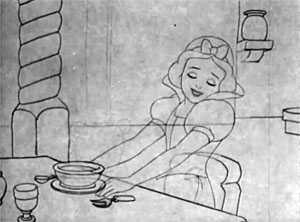 “Even better, the song recorded back in the 1930s was still in the Disney’s vault. Television audiences would finally see an entertaining sequence that had been ‘hidden’ for years.
“Even better, the song recorded back in the 1930s was still in the Disney’s vault. Television audiences would finally see an entertaining sequence that had been ‘hidden’ for years.
“However, once the unseen footage was pulled from the archive, the Old Maestro had a major concern. The animation was fun and entertaining, but the sketches were clearly loose and rough. Perhaps a little too rough for television audiences not used to viewing rough animation.
“Walt Disney made the decision to clean up the footage. He wanted the drawings a little tighter, yet not so much as to lose the energy and vitality of the animator’s original drawings. A crew was needed to get the soup eating sequence ready for prime time.
“The year was 1956, and a group of young animation apprentices had just been hired. Having completed their thirty days of training, the young animation trainees were moved into a large room in 1-F, on the first floor of the Animation Building.
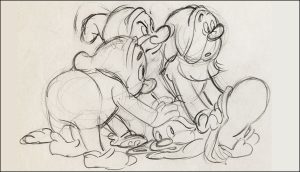 “I was one of those young trainees and our first assignment was to clean-up the rough sketches in Ward Kimball’s soup eating sequence. You can imagine how surprised we were when given the original animated scenes from Walt Disney’s Snow White and the Seven Dwarfs. If was if we were suddenly touching history.
“I was one of those young trainees and our first assignment was to clean-up the rough sketches in Ward Kimball’s soup eating sequence. You can imagine how surprised we were when given the original animated scenes from Walt Disney’s Snow White and the Seven Dwarfs. If was if we were suddenly touching history.
“These were drawings made before some of us were even born, and now it was our responsibility to prepare these amazing scenes for their debut on network television. Perhaps some of you have seen the program where Walt Disney introduces the famous sequence and presents the unseen material for the first time.
“As you can imagine, it was an assignment we’ll never forget. Especially because we were just getting our feet wet as young Disney artists beginning our careers in the cartoon business. And that, boys and girls is how I ended up working on Walt Disney’s Snow White and the Seven Dwarfs.”
As you can tell, Floyd is not only a terrific artist, but a terrific storyteller. Make sure you add a copy of his book Animated Life: A Lifetime of tips, tricks, techniques and stories to your collection. It is filled with lots of great Disney stories. Floyd is also quite active on social media – and his Mr. Fun blog is filled with wonderful stories and, of course, his art.
When Norman posted the story, I wrote to him to ask if Kimball had any reaction to seeing his animation finally shown to an audience. Here is his reply to me:
“The soup eating sequence was one of our first assignments as young Disney newbies. We simply did what we were told and had no idea what guys like Ward Kimball were thinking.
“Walt seemed pleased with what had been done, but I doubt Kimball even saw the sequence. He had his hands full with the new space series he was producing. I think Ward had long since forgotten his work on Snow White and never showed the slightest interest in what we were doing.”
At one point, Walt considered making a sequel to Snow White that would have utilized this scene and the work done on the bed building sequence. The concept was that the Seven Dwarfs receive a message that Snow White is returning for her annual visit. As a gift they make a bed for her. By the time they finish and return to their cottage, Snow White is already there and making a soup dinner.


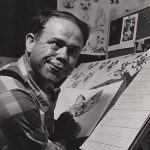
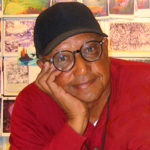
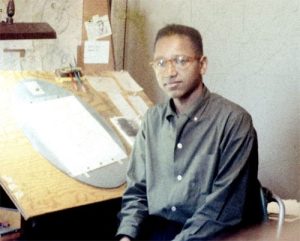
 Jim Korkis is an internationally respected animation historian who in recent years has devoted his attention to the many worlds of Disney. He was a columnist for a variety of animation magazines. With his former writing partner, John Cawley, he authored several animation related books including The Encyclopedia of Cartoon Superstars, How to Create Animation, Cartoon Confidential and Get Animated’s Animation Art Buyer’s Guide. He taught animation classes at the Disney Institute in Florida as well as instructing classes on acting and animation history for Disney Feature Animation: Florida.
Jim Korkis is an internationally respected animation historian who in recent years has devoted his attention to the many worlds of Disney. He was a columnist for a variety of animation magazines. With his former writing partner, John Cawley, he authored several animation related books including The Encyclopedia of Cartoon Superstars, How to Create Animation, Cartoon Confidential and Get Animated’s Animation Art Buyer’s Guide. He taught animation classes at the Disney Institute in Florida as well as instructing classes on acting and animation history for Disney Feature Animation: Florida.




















































I wish Disney would collect their weekly television series somewhere, especially the seasons that were hosted by Walt. They produced some great material.
I keep hoping they do that for Disney+ but they still haven’t done that yet. Maybe for the company’s cenntenial.
If they would put more of their vintage content on Disney+, maybe I would consider re-subscribing. But as-is, it’s just not worth it to me.
Other lands, other customs. In Japan you’re supposed to slurp your soup loudly to show your appreciation for it. I’ll never forget going out to lunch with a group of very proper and elegant ladies who, as one, raised their soup bowls to their lips and made a noise like the world’s biggest rattlesnake nest.
It was very smart of Walt Disney to assign the new trainees to clean up the soup sequence for the Disneyland show. I’m sure a lot of aspiring animators would have thought of cleanup as mere drudgery and a waste of their talents. Working on a scene from Snow White would have been an exciting opportunity for them to contribute to an acknowledged classic, while at the same time gaining experience with techniques that are so important in animated filmmaking. Were so important, I should have said; in a few years, the cleanup techniques the used by the trainees in 1956 would be rendered obsolete by cel xerography.
It’s always a pleasure to read anecdotes about Floyd Norman’s distinguished career in animation. Merry Christmas, Jim!
A lot can be learned by doing clean up and final drawings in animation. I was fortunate enough to be considered qualified to be hired as an Assistant Animator doing Key Clean-ups and Inbetweening in several studios during the 1990s. Since I was up against people who had decades of experience or had graduated from the CalArts program, I worked that much harder to keep up to the standards set before me. I am grateful for the experience.
“My friend and Disney Legend Floyd Norman wrote about cleaning up that segment that was first animated many years before he was even born.”
Jim, you oughta check your facts here. Floyd Norman was born in 1935. So, the soup eating sequence in Snow White was most definitely not animated “many years before he was even born.” 😉 And how could it have been? The cleanup by Norman was done in 1956, just around twenty years after the animation was actually done for the film.
Also, could you elaborate about Walt considering making a “sequel” to Snow White? From everything I’ve read before, Disney was adamant NOT to make a sequel. I’m curious what the sources are for this information.
They was some storyboards that was discovered 15-20 years ago for a scrapped project called “Snow White’s Return” which was basically an excuse to use the planned soup and bed making scenes that were cut from the orginal film. A bonus feature about was included in the Blu-Ray edition of “Snow White” and J.B. Kaufman goes into some details of it in his book “The Fairest One of All””.
They did a great work, but I’d kill for see also the original pencil test, doodles and all..
I just watched “Snow White” again, paying special attention to the dwarfs’ musical numbers. The hootenanny scene reminded me of some of the bands I’ve played in, where the keyboard player is Grumpy, the drummer is Dopey, and the lead singer is the only one who’s Happy.
It’s always painful to learn that a sequence is missing from a beloved film, even if you understand–and even agree with–the reasons for the cut. (In this case it leaves a slight narrative gap: the soup scene shows how Dopey unswallowed the soap.) It’s only when the footage is irretrievably thrown out that it comes close to criminal negligence. If it’s a matter of storage, I bet the artists who worked so hard on the deleted scenes would be happy to archive them once the issue of ownership of the material was resolved.